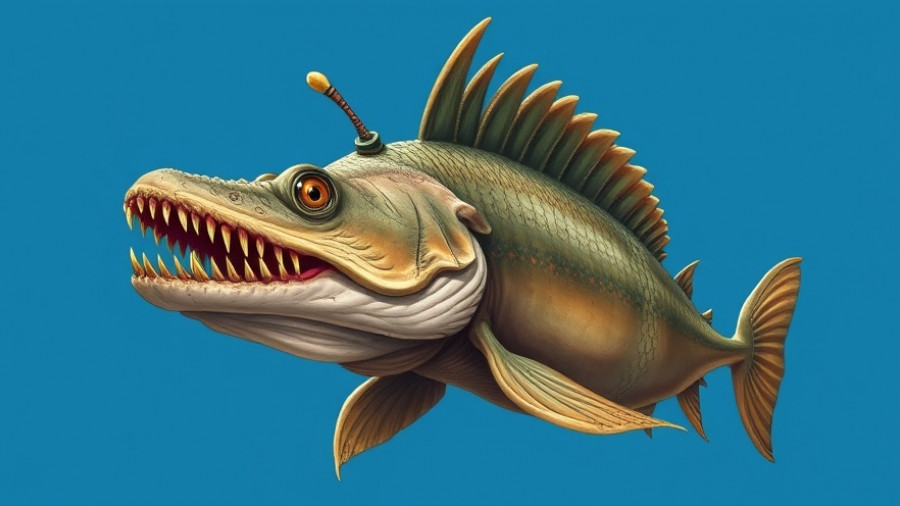
A Revolutionary Discovery: Teeth on the Head of a Fish
In a groundbreaking study, scientists from the University of Washington have unveiled a remarkable evolutionary adaptation in the spotted ratfish, a distant relative of sharks. This peculiar creature, residing in the northeastern Pacific Ocean, has been found to have actual teeth growing on its forehead, a structure known as the tenaculum. This discovery challenges long-held beliefs about tooth evolution, specifically the assumption that teeth are strictly confined to the jaws of vertebrates.
What is the Tenaculum?
The tenaculum is not your everyday anatomical feature; it appears as a club-like structure protruding between the eyes of male spotted ratfish and is adorned with rows of teeth. Young males initially show a small, white bump, which develops into a sizeable, hooked organ once they reach maturity. This unique feature serves multiple purposes: it helps males hold onto females during mating, functioning as a means of securing the pair together in the murky underwater environment where they mate. “Sharks don’t have arms, but they need to mate underwater,” explained Karly Cohen, a postdoctoral researcher at UW. “This adaptation serves as a grasping tool during reproduction.”
Revisiting Evolutionary Assumptions
For decades, the evolutionary narrative surrounding teeth has focused on their presence in the jaws. However, findings from this research raise new questions about whether teeth could have developed in other parts of the body. The genetic analysis revealed that the teeth on the tenaculum share the same genetic roots as oral teeth, indicating that evolutionary pathways may be more diverse and complex than previously thought. This monumental finding opens the door to exploring how other vertebrates utilize dental structures outside the jaw.
From Fossils to Modern Day: An Evolutionary Tale
The researchers examined ancient fossils and compared them with modern ratfish, helping to establish the tenaculum's historical significance in vertebrate evolution. Fossil evidence from species akin to the modern ratfish indicated that similar structures existed in their lineage, suggesting that teeth-like features may have been present long before the appearance of jawed vertebrates. “This insane, absolutely spectacular feature flips the long-standing assumption in evolutionary biology,” said Cohen, emphasizing the need for deeper investigations into the dental evolution across different species.
The Functionality of the Tenaculum
In addition to its role in mating, the tenaculum's growth raises questions about adaptations in vertebrates for grasping or securing partners in reproduction. It extends the notion of what paths evolutionary processes can take to ensure survival. The spotted ratfish's tenaculum is a prime example of how nature finds innovative solutions to life’s challenges, displaying an adaptability that is both fascinating and profound.
What This Means for Future Research
The implications of this discovery stretch far beyond the spotted ratfish. It suggests that the dental structures of vertebrates could be decentralized; thus, more creatures may exhibit such adaptations that were previously overlooked. As Cohen pointed out, “The more we look at spiky structures on vertebrates, the more teeth we are going to find outside the jaw.” Future research may focus on identifying similar structures in other species, which could redefine our understanding of vertebrate anatomy and evolution.
Living in Dallas: A Broader Perspective
The implications of this exciting research extend beyond biology into how we approach our understanding of local environments, just as those living in Dallas experience every day. The Dallas lifestyle presents unique challenges and opportunities, much like those faced by species adapting to survive in vast, competitive landscapes. Considering the natural world's diversity helps remind us to appreciate the unique adaptations found in our communities and beyond. As local lifestyle influencers might suggest, understanding living dynamics — whether in a city like Dallas or underwater with ratfish — is essential for thriving in today’s complex world.
Call to Action: Embrace Quest for Knowledge
Inspired by this revelation in evolutionary biology? Dive deeper into the wonders of nature and science. Explore the complexities of the systems around you, whether through engaging discussions or personal research. The world is rich with mysteries waiting to be discovered!
 Add Element
Add Element  Add Row
Add Row 



Write A Comment